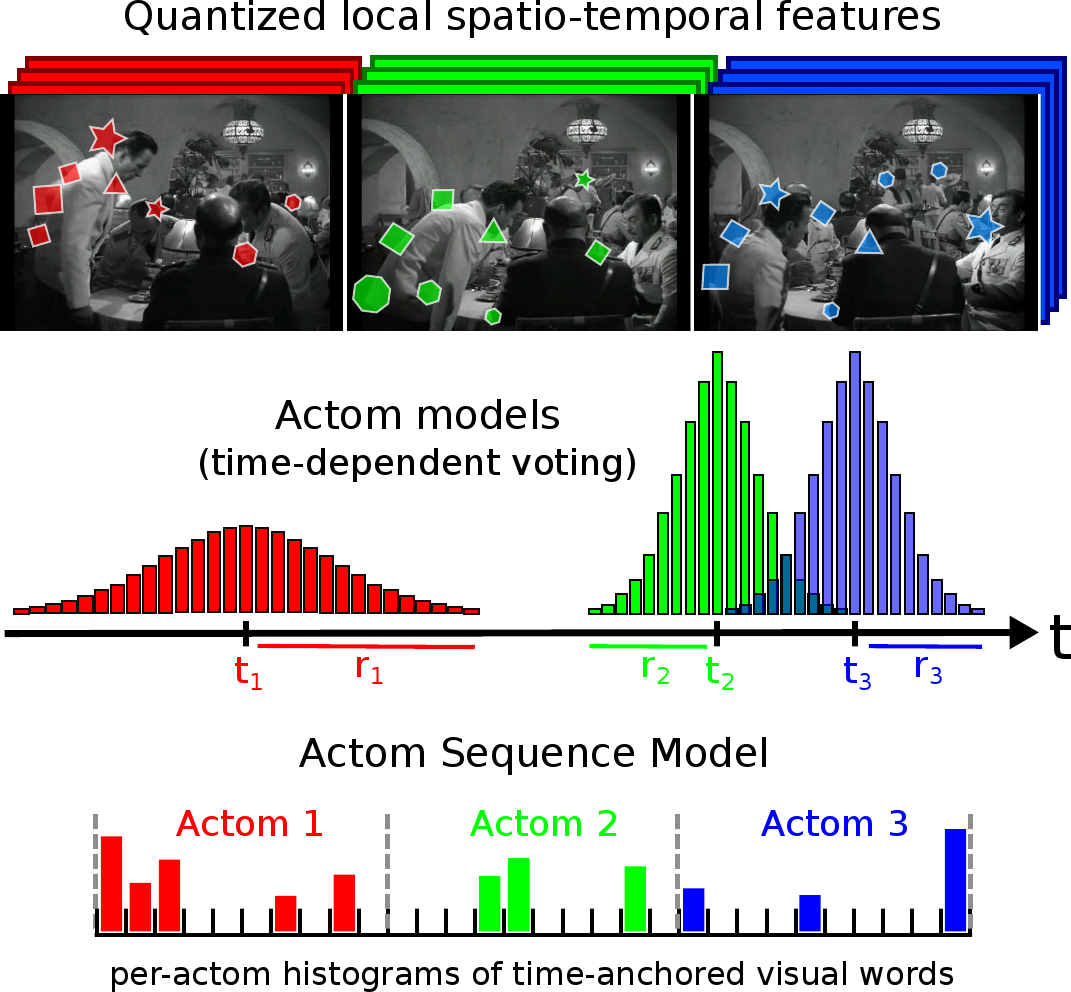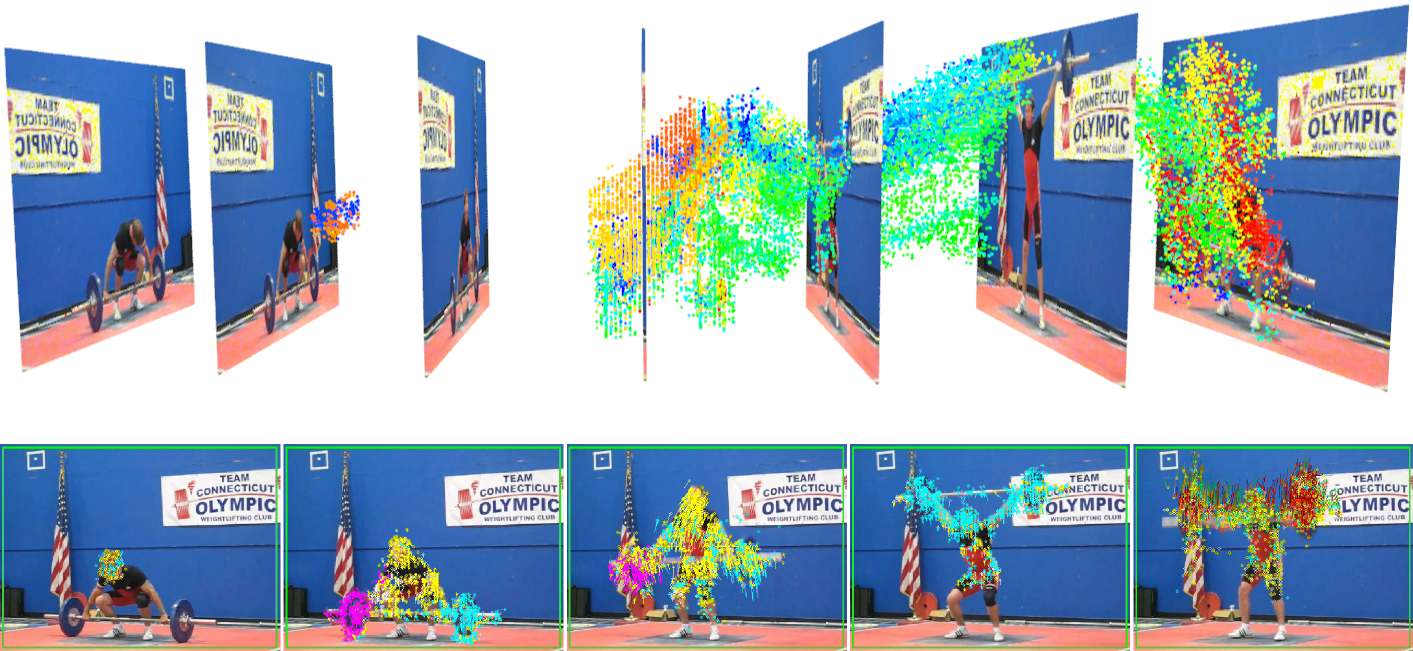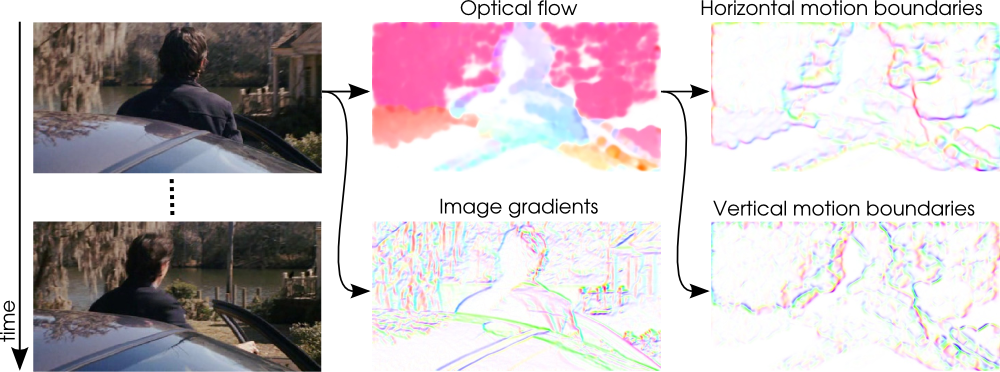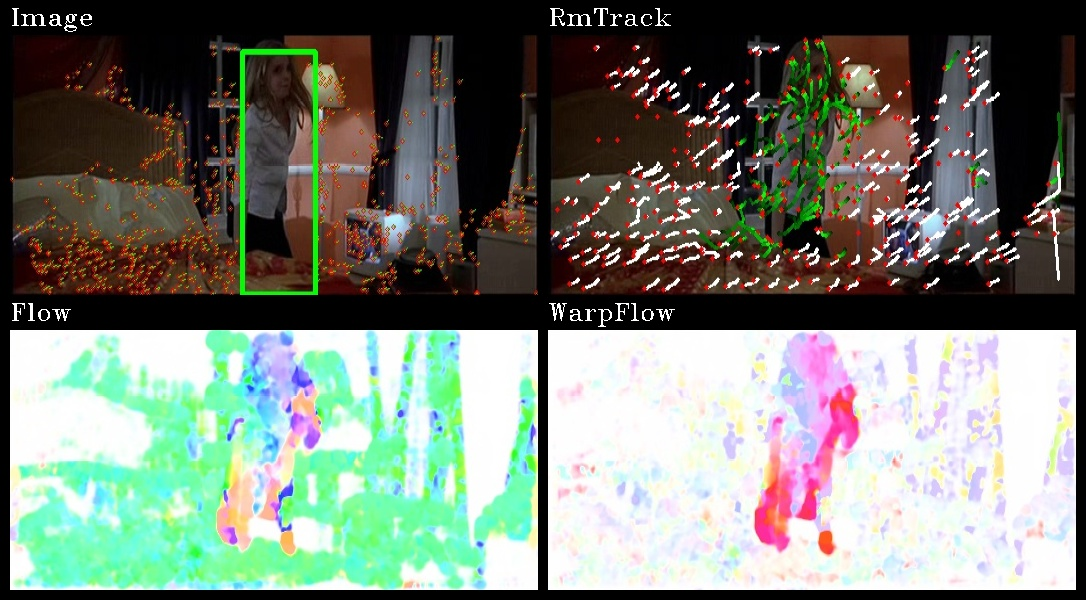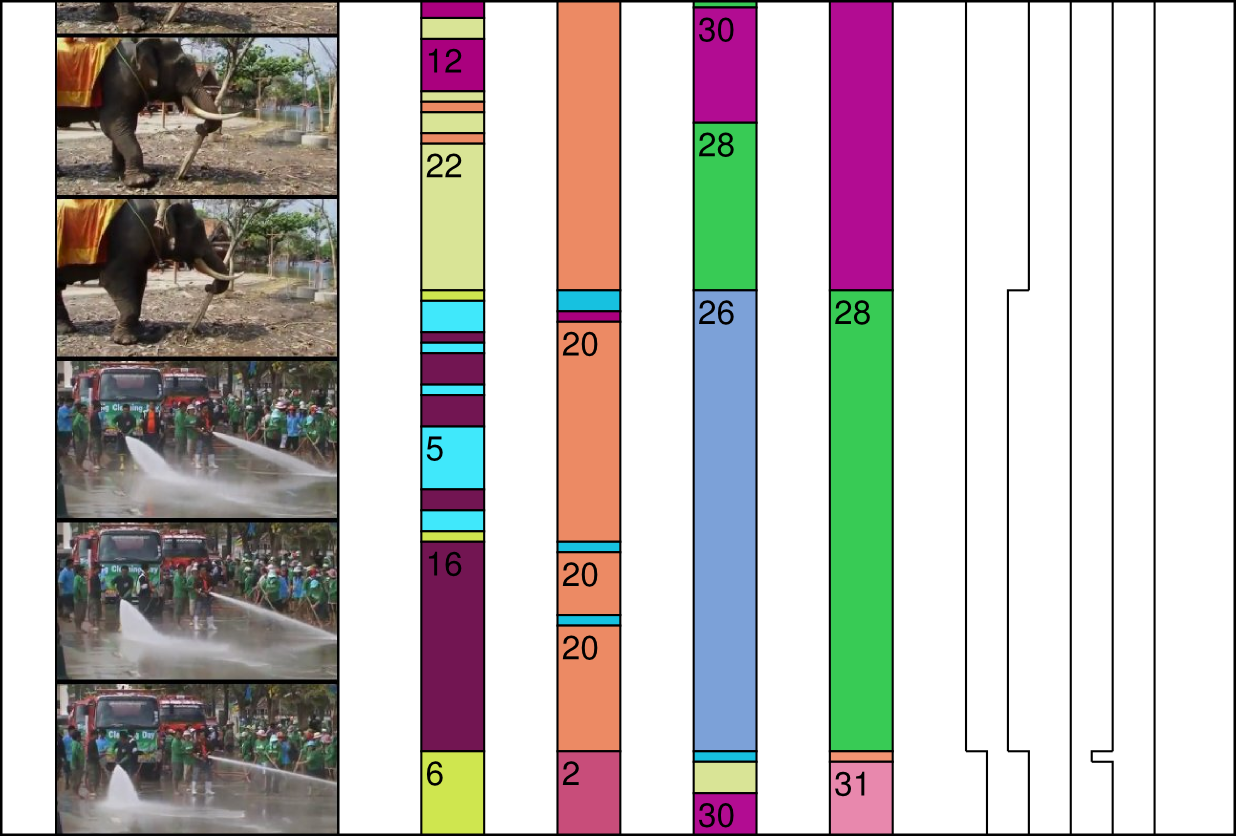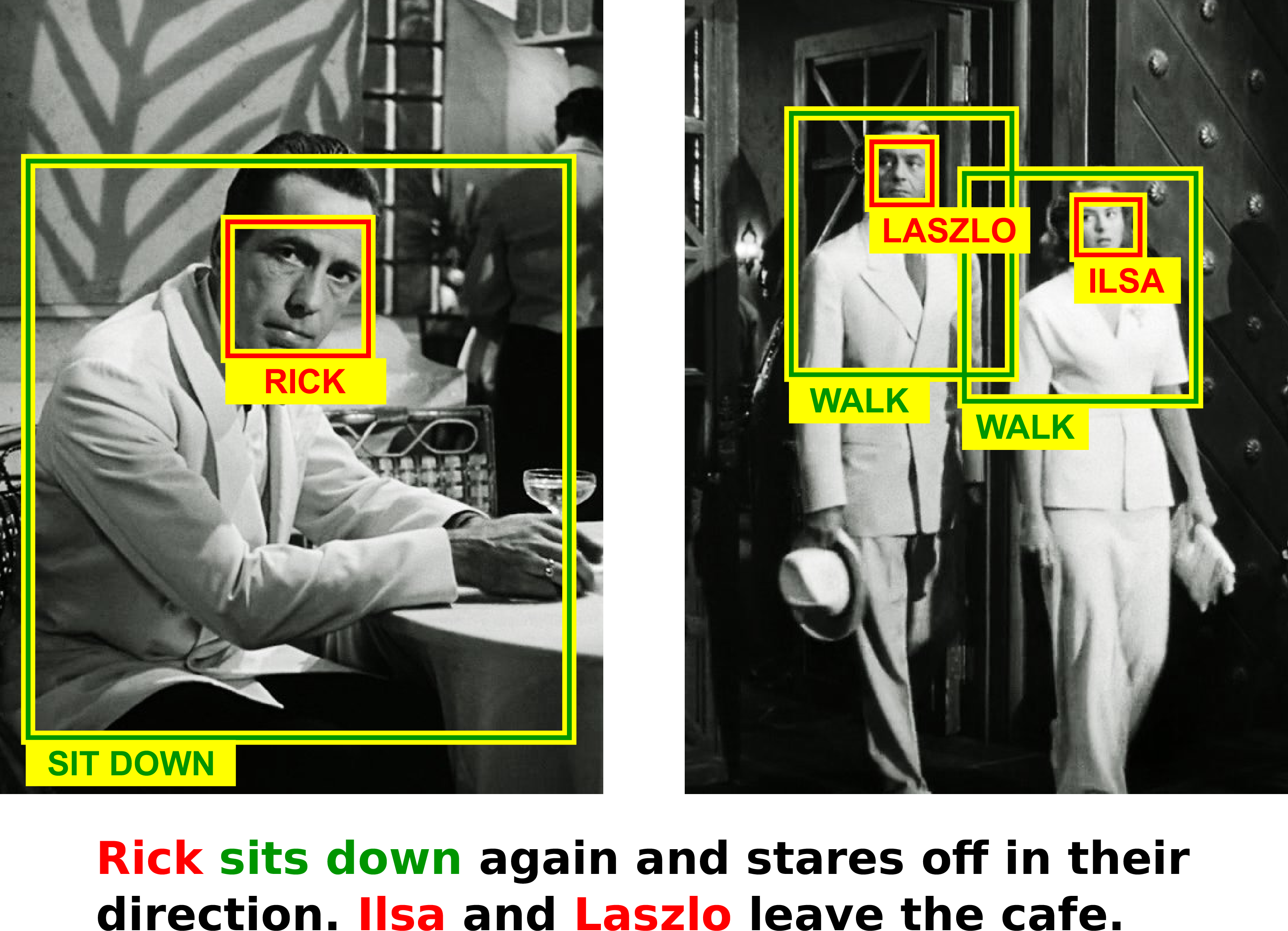Section: New Results
Recognition in video
Temporal Localization of Actions with Actoms
Participants : Adrien Gaidon, Zaid Harchaoui, Cordelia Schmid.
In this paper [4] , we address the problem of localizing actions, such as opening a door, in hours of challenging video data. We propose a model based on a sequence of atomic action units, termed "actoms", that are semantically meaningful and characteristic for the action. Our Actom Sequence Model (ASM) represents an action as a sequence of histograms of actom-anchored visual features, which can be seen as a temporally structured extension of the bag-of-features. Training requires the annotation of actoms for action examples. At test time, actoms are localized automatically based on a non-parametric model of the distribution of actoms, which also acts as a prior on an action's temporal structure. We present experimental results on two recent benchmarks for action localization "Coffee and Cigarettes" and the "DLSBP" dataset. We also adapt our approach to a classification-by-localization set-up, and demonstrate its applicability on the challenging "Hollywood 2" dataset. We show that our ASM method outperforms the current state of the art in temporal action localization, as well as baselines that localize actions with a sliding window method (see Figure 8 ).
Activity representation with motion hierarchies
Participants : Adrien Gaidon, Zaid Harchaoui, Cordelia Schmid.
Complex activities, e.g., pole vaulting, are composed of a variable number of sub-events connected by complex spatio-temporal relations, whereas simple actions can be represented as sequences of short temporal parts. In [3] , we learn hierarchical representations of activity videos in an unsupervised manner. These hierarchies of mid-level motion components are data-driven decompositions specific to each video. We introduce a spectral divisive clustering algorithm to efficiently extract a hierarchy over a large number of tracklets (i.e., local trajectories). We use this structure to represent a video as an unordered binary tree. We model this tree using nested histograms of local motion features. We provide an efficient positive definite kernel that computes the structural and visual similarity of two hierarchical decompositions by relying on models of their parent-child relations. We present experimental results on four recent challenging benchmarks: the High Five dataset, the Olympics Sports dataset, the Hollywood 2 dataset, and the HMDB dataset. We show that per-video hierarchies provide additional information for activity recognition. Our approach improves over unstructured activity models, baselines using other motion decomposition algorithms, and the state of the art (see Figure 9 ).
DeepFlow: Large displacement optical flow with deep matching
Participants : Philippe Weinzaepfel, Jerome Revaud, Zaid Harchaoui, Cordelia Schmid.
Optical flow computation is a key component in many computer vision systems designed for tasks such as action detection or activity recognition. However, despite several major advances over the last decade, handling large displacement in optical flow remains an open problem. Inspired by the large displacement optical flow of Brox and Malik, our approach, termed DeepFlow, blends a matching algorithm with a variational approach for optical flow. We propose in [31] a descriptor matching algorithm, tailored to the optical flow problem, that allows to boost performance on fast motions. The matching algorithm builds upon a multi-stage architecture with 6 layers, interleaving convolutions and max-pooling, a construction akin to deep convolutional nets. Figure 10 shows an outline of our approach. Using dense sampling, it allows to efficiently retrieve quasi-dense correspondences, and enjoys a built-in smoothing effect on descriptors matches, a valuable asset for integration into an energy minimization framework for optical flow estimation. DeepFlow efficiently handles large displacements occurring in realistic videos, and shows competitive performance on optical flow benchmarks. Furthermore, it sets a new state-of-the-art on the MPI-Sintel dataset.
Event retrieval in large video collections with circulant temporal encoding
Participants : Jerome Revaud, Matthijs Douze, Cordelia Schmid, Hervé Jégou.
This paper [28] presents an approach for large-scale event retrieval. Given a video clip of a specific event, e.g., the wedding of Prince William and Kate Middleton, the goal is to retrieve other videos representing the same event from a dataset of over 100k videos. Our approach encodes the frame descriptors of a video to jointly represent their appearance and temporal order. It exploits the properties of circulant matrices to compare the videos in the frequency domain. This offers a significant gain in complexity and accurately localizes the matching parts of videos, see Figure 11 . Furthermore, we extend product quantization to complex vectors in order to compress our descriptors, and to compare them in the compressed domain. Our method outperforms the state of the art both in search quality and query time on two large-scale video benchmarks for copy detection, Trecvid and CCweb. Finally, we introduce a challenging dataset for event retrieval, EVVE, and report the performance on this dataset.
|
Dense trajectories and motion boundary descriptors for action recognition
Participants : Heng Wang, Alexander Kläser, Cordelia Schmid, Cheng-Lin Liu.
|
This paper [11] introduces a video representation based on dense trajectories and motion boundary descriptors. Trajectories capture the local motion information of the video. A state-of-the-art optical flow algorithm enables a robust and efficient extraction of the dense trajectories. As descriptors we extract features aligned with the trajectories to characterize shape (point coordinates), appearance (histograms of oriented gradients) and motion (histograms of optical flow). Additionally, we introduce a descriptor based on motion boundary histograms (MBH) (see the visualization in Figure 12 ), which is shown to consistently outperform other state-of-the-art descriptors, in particular on real-world videos that contain a significant amount of camera motion. We evaluate our video representation in the context of action classification on nine datasets, namely KTH, YouTube,Hollywood2, UCF sports, IXMAS, UIUC, Olympic Sports, UCF50 and HMDB51. On all datasets our approach outperforms current state-of-the-art results.
Action Recognition with Improved Trajectories
Participants : Heng Wang, Cordelia Schmid.
|
This paper [30] improves dense trajectories by taking into account camera motion to correct them. To estimate camera motion, we match feature points between frames using SURF descriptors and dense optical flow, which are shown to be complementary. These matches are, then, used to robustly estimate a homography with RANSAC. Human motion is in general different from camera motion and generates inconsistent matches. To improve the estimation, a human detector is employed to remove these matches. Given the estimated camera motion, we remove trajectories consistent with it. We also use this estimation to cancel out camera motion from the optical flow. This significantly improves motion-based descriptors, such as HOF and MBH (see Figure 13 ). Experimental results on four challenging action datasets (i.e., Hollywood2, HMDB51, Olympic Sports and UCF50) significantly outperform the current state of the art.
Action and event recognition with Fisher vectors on a compact feature set
Participants : Dan Oneaţă, Jakob Verbeek, Cordelia Schmid.
Action recognition in uncontrolled video is an important and challenging computer vision problem. Recent progress in this area is due to new local features and models that capture spatio-temporal structure between local features, or human-object interactions. Instead of working towards more complex models, we focus in this paper [27] on the low-level features and their encoding. We evaluate the use of Fisher vectors as an alternative to bag-of-word histograms to aggregate a small set of state-of-the-art low-level descriptors, in combination with linear classifiers. We present a large and varied set of evaluations, considering (i) classification of short actions in five datasets, (ii) localization of such actions in feature-length movies, and (iii) large-scale recognition of complex events. We find that for basic action recognition and localization MBH features alone are enough for state-of-the-art performance. For complex events we find that SIFT and MFCC features provide complementary cues. On all three problems we obtain state-of-the-art results, while using fewer features and less complex models.
Stable hyper-pooling and query expansion for event detection
Participants : Matthijs Douze, Jerome Revaud, Cordelia Schmid, Hervé Jégou.
This work [19] makes two complementary contributions to event retrieval in large collections of videos. First, we compare different ways of quantizing video frame descriptors in terms of temporal stability. Our best choices compare favorably with the standard pooling technique based on k-means quantization, see Figure 14 . Second, we introduce a technique to improve the ranking. It can be interpreted either as a query expansion method or as a similarity adaptation based on the local context of the query video descriptor. Experiments on public benchmarks show that our methods are complementary and improve event retrieval results, without sacrificing efficiency.
|
Finding Actors and Actions in Movies.
Participants : Piotr Bojanowski, Francis Bach, Ivan Laptev, Jean Ponce, Cordelia Schmid, Josef Sivic.
This work [16] addresses the problem of learning a joint model of actors and actions in movies using weak supervision provided by scripts. Specifically, we extract actor/action pairs from the script and use them as constraints in a discriminative clustering framework. The corresponding optimization problem is formulated as a quadratic program under linear constraints. People in video are represented by automatically extracted and tracked faces together with corresponding motion features. First, we apply the proposed framework to the task of learning names of characters in movies and demonstrate significant improvements over previous methods used for this task. Second, we explore joint actor/action constraints and show their advantage for weakly supervised action learning. We validate our method in the challenging setting of localizing and recognizing characters and their actions in the feature length movies Casablanca and American Beauty. Figure 15 shows an example of our results.


